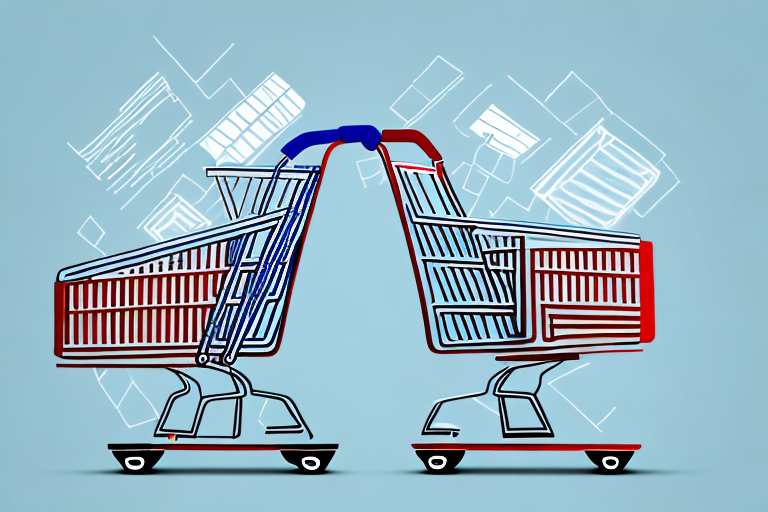WooCommerce Increases Shipping Rates: What You Need to Know
WooCommerce, one of the leading e-commerce platforms, recently announced a significant increase in shipping rates. The changes will impact businesses of all sizes and could lead to a rise in costs for consumers. In this article, we'll explore the impact of this decision, provide tips for mitigating its effects on your business, and update you with the latest insights on shipping trends.
Understanding the Impact of WooCommerce's Shipping Rate Increase on Your Business
One of the most significant impacts of WooCommerce's rate increase is the potential for elevated shipping costs for your business. According to recent industry reports, shipping costs have risen by an average of 8% over the past year, influenced by factors such as increased fuel prices and supply chain disruptions. While the exact cost increase will depend on your shipping volume and customers' locations, you can expect to pay more for each shipment. This cost increase may be substantial enough to impact your bottom line and may require a change in your pricing strategy.
Additionally, the rate increase may add complexity to your shipping operations. You may need to adjust your shipping settings or explore alternative shipping options to ensure your business remains profitable. This change will require careful monitoring and strategic planning to ensure a smooth transition.
Another potential impact of the rate increase is on customer satisfaction. If your customers are accustomed to a certain level of shipping speed or cost, they may be unhappy with any changes resulting from the rate increase. It's crucial to communicate any changes transparently to your customers and provide them with alternative options if necessary.
Furthermore, the rate increase may also affect your competition. If your competitors are not affected by the rate increase, they may be able to offer lower prices or faster shipping, potentially leading to a loss of customers for your business. It's essential to stay informed about your competitors' shipping rates and adjust your strategy accordingly.
The Reasons Behind WooCommerce's Decision to Raise Shipping Rates
The decision to raise shipping rates was made in response to escalating shipping costs and a need to maintain profitability. The cost of shipping has surged significantly in recent years, with the ShipScience Industry Report indicating a 12% increase in global shipping expenses over the past 18 months. To ensure the continued sustainability of the platform, WooCommerce has decided to pass on some of these costs to its customers.
While this decision may be unpopular with some businesses and customers, it is essential to remember that WooCommerce is a business that needs to remain profitable to continue providing services to its customers.
WooCommerce has also implemented measures to mitigate the impact of the shipping rate increase on its customers. For example, the platform has negotiated better rates with shipping carriers and introduced a tiered pricing system based on order size and destination. These measures aim to provide customers with more affordable shipping options while still covering the costs of shipping.
Furthermore, the decision to raise shipping rates is not unique to WooCommerce. Many other e-commerce companies have also had to increase their shipping rates due to rising costs. By doing so, WooCommerce is aligning itself with industry standards and ensuring that it remains competitive in the market.
How the WooCommerce Shipping Rate Increase Compares to Competitors in the Market
While the WooCommerce rate increase may seem substantial, it is important to compare it with competitors in the market. Giants like Amazon and Walmart benefit from economies of scale, allowing them to offer significantly lower shipping rates due to their size and ability to negotiate bulk shipping discounts. However, smaller e-commerce platforms may face similar increases in shipping rates, making it crucial to monitor the market and adapt as needed.
Shipping rates can vary depending on the customer's location and the package's destination. For example, international shipping rates are often significantly higher than domestic rates. Additionally, some competitors may offer free shipping for certain order sizes or promotional periods, which can be a major selling point for customers. Therefore, it is important for e-commerce businesses to consider all factors when determining their shipping rates and promotions.
Tips for Mitigating the Effects of WooCommerce's Shipping Rate Increase on Your Customers
The rate increase may cause concern among your customers and could lead to negative feedback. To mitigate these effects, it's important to communicate the changes effectively. Be transparent about the reasons for the increase and explain how it will impact your business and your customers. Consider offering incentives to offset the additional shipping costs, such as free shipping thresholds or coupon codes.
Additionally, ensure that your shipping policies are clear and easy to understand, allowing customers to make informed decisions when making purchases from your store.
Another way to mitigate the effects of the shipping rate increase is to offer alternative shipping options. For example, you could offer a slower, more affordable shipping option for customers willing to wait longer for their items to arrive. This can help reduce the impact of the rate increase on your customers while still allowing you to cover your shipping costs.
Finally, it's important to monitor customer feedback and adjust your approach as needed. If you notice that customers are still unhappy with the shipping rates, consider revisiting your shipping policies or exploring alternative shipping providers. By staying responsive to customer feedback, you can ensure that your business continues to meet the needs of your customers, even in the face of external challenges like shipping rate increases.
Exploring Alternative Shipping Options for Your Online Store in Light of WooCommerce's Changes
One way to mitigate the effects of the rate increase is to explore alternative shipping options. Consider working with different carriers or exploring alternative shipping methods such as dropshipping or local fulfillment. These options could provide cost savings and help maintain profitability despite the rate increase.
Another option to consider is implementing a shipping strategy that encourages customers to purchase more items at once. This could include offering free shipping for orders over a certain amount or providing discounts on shipping for larger orders. By incentivizing customers to purchase more items at once, you can reduce the overall shipping costs per item and increase your profit margins.
Additionally, it may be worth exploring the use of shipping software or services that can help optimize your shipping process. These tools can help you compare rates across multiple carriers, automate shipping label creation, and streamline your overall shipping workflow. By using these tools, you can save time and money while still providing reliable and efficient shipping to your customers.
The Role of Free Shipping in E-commerce and How it Factors into WooCommerce's New Rates
Free shipping has become a standard offering in e-commerce, but it comes at a significant cost to businesses. WooCommerce's rate increase may make it more challenging to offer free shipping to customers, but it is important to remember that free shipping is not necessary for a profitable business. Consider other incentives, such as loyalty programs or coupon codes, that could be more cost-effective than free shipping.
Calculating the True Cost of Shipping for Your Business After WooCommerce's Rate Hike
To adjust your pricing strategy effectively, it is essential to understand the true cost of shipping for your business. Analyze your shipping costs carefully and factor in the WooCommerce rate increase to determine the true cost of shipping for each order. This analysis will help you make informed decisions about pricing and maintain profitability despite the rate increase.
How to Communicate the Changes in Shipping Rates to Your Customers and Minimize Negative Feedback
Effective communication is key when it comes to changes in shipping rates. Be transparent about the reasons for the rate increase and communicate the changes proactively with your customers. Use clear and concise language, and consider providing additional context or explaining how the change will impact your business and your customers. By communicating effectively, you can minimize negative feedback and ensure a smooth transition for your business and your customers.
What Impact Will the Change in WooCommerce's Shipping Rates Have on Your Bottom Line?
The impact of the rate increase on your bottom line will depend on various factors, including your shipping volume, customer locations, and pricing strategy. It is essential to analyze these factors carefully to ensure that your business remains profitable after the rate increase. Adjust your pricing strategy as necessary and consider exploring alternative shipping options to maintain profitability in the long term.
How to Adjust Your Pricing Strategy to Account for WooCommerce's Increased Shipping Costs
Adjusting your pricing strategy is essential after a rate increase. Consider increasing your product prices or introducing a shipping fee to offset the higher costs. Additionally, consider offering value-added services or unique products that justify the higher costs to your customers. By adjusting your pricing strategy, you can maintain profitability despite the rate increase.
A Look at the Long-Term Effects of WooCommerce's Shipping Rate Increase on the E-commerce Industry
The rate increase may have significant long-term effects on the e-commerce industry. It may lead to more substantial consolidation among e-commerce platforms and carriers, as smaller companies struggle to remain profitable. Additionally, it may lead to a re-evaluation of pricing strategies and incentives as businesses adapt to the higher shipping costs. The full impact of the rate increase is yet to be seen, but it is clear that the e-commerce industry will continue to evolve as a result.
The Pros and Cons of Absorbing the Cost of WooCommerce's Higher Shipping Rates Versus Passing it on to Customers
Absorbing the cost of the rate increase could lead to lower customer acquisition costs and a more positive customer experience. However, it may also lead to lower profitability and may not be sustainable in the long term. Passing on the cost to customers could lead to negative feedback but may be necessary to maintain profitability. Ultimately, the decision will depend on your business's unique situation and goals.
Steps to Take if You're Considering Switching E-commerce Platforms Due to WooCommerce's New Rates
If you're considering switching e-commerce platforms due to the rate increase, it's essential to research your options carefully. Consider the pricing and shipping policies of different platforms, and explore their features and functionalities to ensure they meet your business's needs. Additionally, evaluate the costs and benefits of a platform switch and determine if it is the right decision for your business.
Best Practices for Managing Customer Expectations Around Shipping Costs After a Price Increase
Managing customer expectations is critical after a price increase. Be transparent about the increase and explain how it will impact their experience. Consider offering incentives or discounts to offset the increased costs, and ensure that your shipping policies and pricing are clear and easy to understand. By effectively managing customer expectations, you can maintain customer loyalty and ensure a positive customer experience.
Conclusion
The rate increase by WooCommerce is a significant change that will impact the e-commerce industry in the coming months and years. However, by understanding the impact of the increase and adjusting your business's strategy accordingly, you can maintain profitability and provide a positive customer experience. Remember to communicate clearly with your customers and explore alternative shipping options to ensure a smooth transition.




















